Kington St Michael's History
Villager, Tim Storer, has kindly composed a comprehensive history of the parish.
Wiltshire & Swindon History Centre also has a Community History Website, which includes information on Kington St Michael.
Kington St Michael was originally called Kington, indicating a royal farm or manor, and was first recorded in a Saxon document in 934 AD.
The village is sited on a brash limestone outcrop and remains a street village in pattern to this day. The church of St Michael and All Angels dates back to the twelfth century (the story of St Michael) There used to be a sheep market held in the area in front of the Almshouses, and other markets held in enclosures nearby (the area in front of 77 and 78 Kington St Michael, for example). "The Jolly Huntsman" pub (a Grade II listed building) was originally called "The White Horse" and contained the brewery at the back of its premises. The wells supplying the water are 80 feet deep and are still accessible to this day. It is reputed that there was a tunnel between "The White Horse" and "The White Hart" opposite (today a private dwelling house). A smaller hostelry on the main street was located at what is now 75 Kington St Michael.
Here are details of the Domesday map.
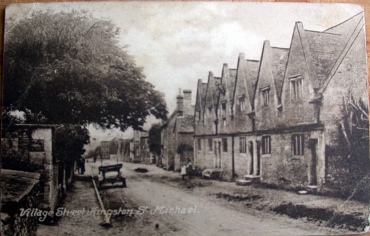
(An old postcard showing the Alms Houses, circa 1920s - kindly provided by Tim Storer)
The Manor House was rebuilt in the 1860s by Squire Herbert Prodgers. He also gave the village its school and schoolhouse, which was used until the late 1970s when the current school was built. (More information about Herbert Prodgers can be found on the Past Residents page).
The Village undertook a twelve year battle to save the old school premises for the benefit of the Parish, and is probably one of the very few in the country which retained their premises once they ceased to be used for educational purposes. The Reversioner for the property, a Mrs Rogers, gave the building back to the Village in the 1980s. The Parish Council was subsequently able to gain hold of the schoolhouse and the playground land, with a change in the law with regard to charities.
A major fund raising exercise in the village enabled the whole building to be converted into a well-used Parish Hall, which was given charitable status by the Parish Council at that point. The complex of old and new Parish Halls will be of major benefit to the area in the years to come. Here is a history of the acquisition of the village hall.
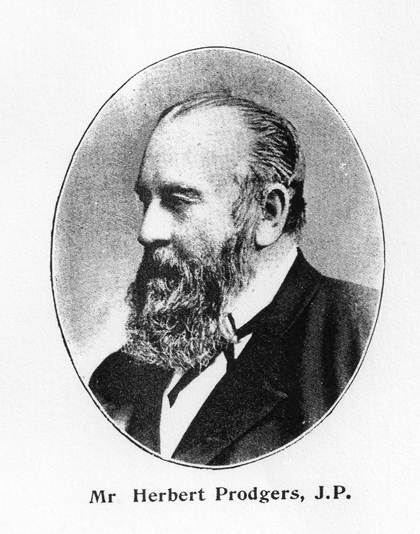 |
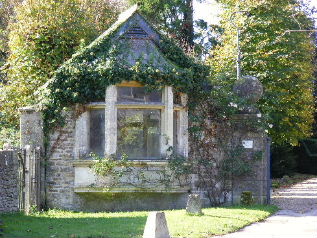 |
|
Squire Prodgers and his gatehouse |
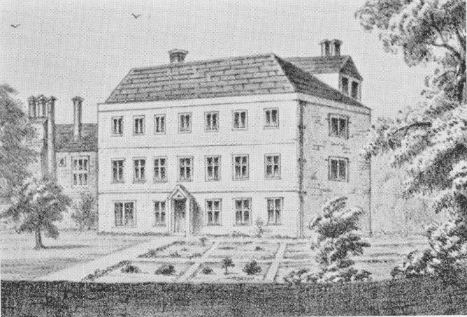 |
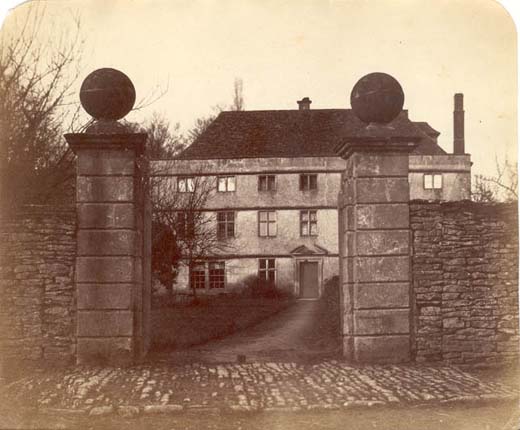 |
|
The old Manor House, demolished in the late 1800s The old Manor House (Circa late 19th century)
(Thanks to David West for providing the picture on the left from the Parish Plan) |
Originally Kington St Michael included the the hamlet of Kington Langley, but this became a separate parish in 1865. The burial grounds are maintained in the Parish Church, and the two villages retain responsibility for the six Almshouses located in Kington St Michael. Lands in the parish were bestowed upon Glastonbury Abbey and a house of Benedictine nuns was established at The Priory. For further information visit Wiltshire Council's website.
The hamlet of Easton Piercy is now part of the parish of Kington St Michael but until late in medieval times was a separate village and parish with its own small chapel, graveyard and cross. The chapel was taken down around 1610. The early name was Easton Piers from the Piers family who owned the manor in the mid 12th century. Easton Piercy was part of the Malmesbury Hundred.
Kington St Michael Priory
Kington St. Michael Priory was a Benedictine priory of nuns. Founded before 1155, the priory was dissolved in 1536.
Parts of the priory buildings from the 13th and 15th centuries were incorporated into the present Priory Farm, where there is also modern rebuilding on old foundations.
The last Prioress of Kington was Dame Marie Denys, a daughter of Sir William Denys (1470–1533) of Dyrham, Gloucestershire and Lady Ann Berkeley, da. of Maurice, de jure 3rd Baron Berkeley (d.1506). She had previously been a nun at Lacock Abbey, and had just taken up her new appointment at the start of the Dissolution of the Monasteries; in the summer of 1535 the King's visitors came to Lacock and made a favourable report. John ap Rice wrote that he had 'founde no notable compertes there' and commended the nuns of Lacock for their familiarity with their rule and constitutions, he informed Thomas Cromwell that Dame Marie Denys, 'a faire young woman of Laycock', had been made Prioress of Kington, where the visitation had revealed a less satisfactory state of affairs. The report of the Commissioners of 1536 upon Kington was however favourable.
Marie Denys lived until at least 1571 when she was bequeathed by the will of her brother Sir Walter Denys (1501–1571) his second best bed, situated at the home of his second wife at Codrington, near Dyrham: "Item I geve my second best bed with blanketts coverled, bolster thereunto belonginge being nowe in Codrington unto my sister Marye Denys"
In 1221 a house for paupers was built in the parish at The Priory - visit www.workhouses.org.uk and enter "Kington St Michael" in the search box for details.
The image below is of "The Annunciation to Mary", which was once held in the Benedictine Priory at Kington St Michael.
To find out more about The Priory please visit the British History website and Wikipedia.
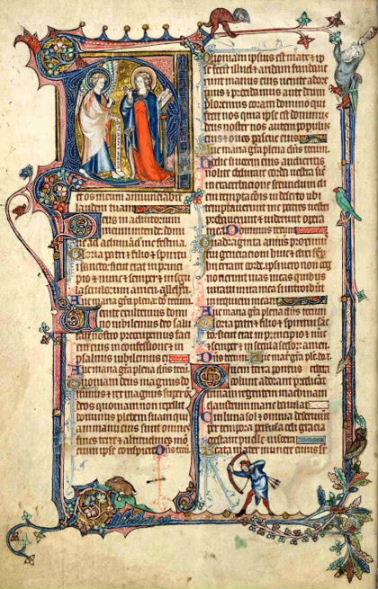
Visit www.wiltshiretreasures.org/ and enter "Kington St Michael" in the search box to view artifacts related to the village.
Heritage Gateway is a website where you can search for information on England's historic sites and buildings, including images of listed buildings. It also includes some interesting information about Kington St Michael.
Another interesting website is the OodWooc website, compiled by Duncan & Mandy Ball. It contains 229 photographs of Kington St Michael church & churchyard. Do have a good look around it, as there are lists of those buried plus photos of gravestones.
For local historical information visit Wiltshire & Swindon History Centre's website.
View Wiltshire Community Histories on Wiltshire Council's website here, (which includes Kington St Michael) then select the parish you wish to view.
Know Your Place – West of England, the digital mapping project that is putting your neighbourhood’s heritage on the map www.kypwest.org.uk.
To view the Wiltshire On-line Parish Clerk's website click here - you will need to log in before searching for Kington St Michael. This has details of baptisms, marriages and burials from as early as 1791 to around 1911.
Wiltshire On-line Parish Clerk's website contains supplementary pages for Kington St Michael.
To search for past births, marriages and deaths please take a look at the Wiltshire BMD website.
The Rev J E Jackson wrote about Kington St Michael in the The Wiltshire Archaeological and Natural History Society Magazine No. X, Vol. IV, June 1857, is available to read on the Biodiversity Heritage Library website.
Kington St Michael "Landscape, Settlement & Buildings" (copyright University of London 2023)
You can view The Return of Owners of Land, Kington St Michael 1873.
Kington St Michael Map and Tithe 1842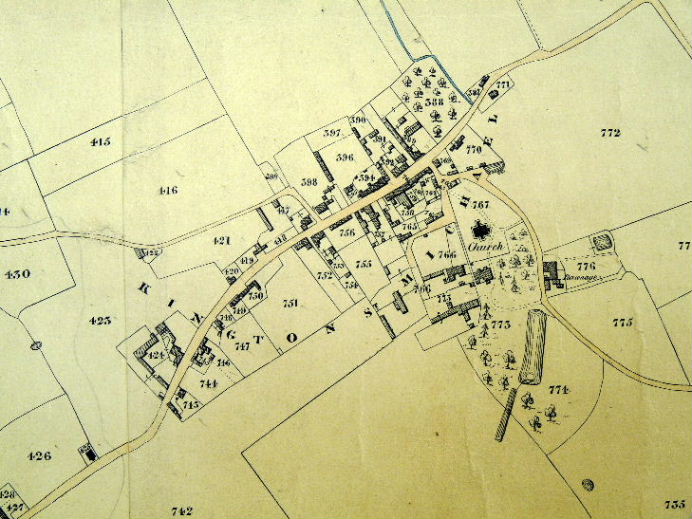
Please click here for the corresponding 1842 tithe.
Please click here for the 1840 tithe.
Interesting to note that there was a James Bond in the village!
Almshouses
In 1672 Isaac Lyte*, a native of Kington St
Michael, born in 1612, who became an alderman of the City of London,
left £600 for the building of almshouses for six poor unmarried men of
the parishes of Kington St Michael and Kington Langley. They were
completed in 1675 and are the oldest secular buildings in the parish.
(*Isaac Lyte was the cousin of John Aubrey).
History of Hillside House (taken from the Deeds)
1800s
James Mascall senior lived in a derelict house on the present site at this time. After he died in 1821, his son who was also called James, demolished the dwelling and built a 2-bedroom house with 2 attics. Access to the upper floors was possible by a rope ladder. The tenant at that time was called William Humphries. 15th February 1834The house was sold by public auction at The White Hart Public House, Kington St Michael (now a residential dwelling - 3 & 3A Kington St Michael), Kington St Michael, for £149 10s to Mr Charles Beak and Mr Broome Penniger. Mr Beak was an Innkeeper at Ford and Mr Penniger was listed as a ‘Gentleman’.Charles Beak died and left the house to his son William. Around this time there were two tenants in the house, a Thomas Pike and Thomas Weston.29th March 1864William Beak raised a mortgage on the house by borrowing £100 from Amelia Barnes; the interest on the mortgage was 5%.17th March 1865William Beak had re-paid the interest due on the mortgage but no principal. He sold the house to Amelia Barnes for £180, less the mortgage of £100. It is interesting to note from the Deeds that Amelia Barnes signed the indenture with a cross. At this time the house had a tenant called William Turk.25th June 1872Amelia Barnes signed her last will and died two days later, leaving the house in possession of her niece Amelia Granger – the only child of John Granger and his wife Maria (nee Barnes), but the house was owned by Maria Granger.7th July 1889Amelia Granger died on 21st March and the house reverts to Maria Granger of Albany, New York, USA. Maria passes it to her eldest son of the nine children she had by her then husband William whom she married at St Pancras London. William came from Corsham, Wiltshire and died in Albany, New York.17th March 1890William Granger sold the house to Robert Aland, farmer of Christian Malford, for £50, subject to the lifetime possession of his mother. The tenant at this time is William Dove. The house is identified as number 771 of the 1842 tithe map (see map above on this page). 1904The house is extended and renovated, giving it 3 reception rooms, kitchen, three bedrooms, bathroom and two attic rooms.29th September 1906Robert Aland leases the house to Herbert Prodgers who resides at Kington House, the manor of Kington St Michael, for 21 years.19th April 1919Robert Aland died and his children sell the house to George Malcom Thompson of The Old Malthouse, Worpleton, Surrey on 16th October 1919 for £500. On the same date George Thompson buys from G J Prodgers all the properties and land of the Kington Manor estates, comprising 171.2 acres in Kington St Michael and Kington Langley for £11,500. He then mortgages the estate for £5,034 at an interest rate of 5.5%, repaying it on August 1946. The tenant during this period was Mr Dench*, the groom and his family. *Mr Dench’s grandson, who now lives in Canada, visited the property in 2008 whilst visiting family in England. His Mother was still alive at that time, living in Shipton Moyne.15th April 1946George Thompson sold the whole of Kington Manor Estate, except Hillside House, for £22,000 to two spinsters, the Misses E.K Godman and G W Godman of 7 Cecily Hill, Cirencester. They raised a mortgage with The Norwich Union Life Insurance Society for £1,000.28th October 1946George Thompson moves to Westend, Shipton Moyne, and sells Hillside House to Reginald Cogswell of Bath for £1,800. Mr Cogswell raises a mortgage of £1,300 with the Bath Liberal Building Society.5th November 1947Reginald Cogswell sells the house to Naomi Loveday Corbyn and her husband David Corbyn for £2,400. They had two sons Jeremy (Labour MP and leader of the party from 2015 – 2020) and Piers Corbyn who became a weather forecaster and anti-vaccination activist.28th April 1948Misses EK and GW Gooodman of Kington Manor, sell extra land to the west of Tor Hill for £50 to Naomi and David Corbyn. After this time the garages and drive were added and the stream was put in a culvert over which a lawn was created.18th November 1960Naomi Corbyn sells the house to Eric John Garner for £3,250. John Garner raises a mortgage with the Halifax Building Society for £1,750 at an interest rate of 6% over 20 years. He pays it off on 21st August 1979. Mr & Mrs Garner were responsible for planting most of the trees during this period. John Garner became bankrupt and moved to Yorkshire in 1979 where his wife joined him in 1980.23rd June 1980Hillside House is sold to Ivan and Avril Balmforth for £62,500. They raised a mortgage with the Ramsbury Building Society at an "astronomical" interest rate of 16%. The mortgage was paid off in 1989. They had three children, Karen; Louise and Matthew.15th March 2010Ivan Balmforth died aged 69, leaving the property to his wife Avril.September 2013
Avril Balmforth sold Hillside House to Alan and Victoria Ingham who, over time, renovated the property, internally adding a bathroom to the top floor and on suite to a bedroom on the first landing.
2018
A full width extension was added to the rear of the house.December 2021
Plans were approved to demolish garage and workshop and replace with a garden room, to include an office and ancillary living space.
February 2024
The garage was demolished and work began on the garden room.
Manor Cottage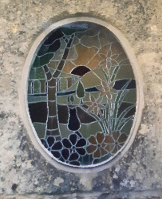 Manor Cottage used to have this stained glass window in its gable end. At some point this was removed, possibly in the 2000s/2010s.
Manor Cottage used to have this stained glass window in its gable end. At some point this was removed, possibly in the 2000s/2010s.
Village Clock
Those of you with good memories will recall that there used to be a clock in the window of the Old Village Hall (facing onto the road, next to the telephone kiosk). This had been bought to commemorate the coronation of Queen Elizabeth II, but sadly it wore out in the 1990s and was irrepairable. However, due to popular demand, the Village Hall Management Committee bought a new clock and it has been put up in its rightful place.
The Pond Area, Stubbs Lane
Have you ever why the pond area is called that when it really looks more like a stream? Years ago the land there and Tor Hill and Home Farm (now Home Farm House) all belonged to Kington Manor. Home Farm had a herd of Jersey cattle which were led down cobbles to water at the pond. Subsequently the pond area has reduced in size and, presumably, the cobbles are hidden beneath. (Thanks go to Robbie Duckett for this information).
In June 2014 an application to register land know as the
Pond(s), Stubbs Lane, Kington St Michael, as a Village Green was considered by Wiltshire Council, which made a decision on
this case and concluded that the land should be registered as a
Village Green - here's the Village Green registration decision letter.
N.B. take a look at the 1842 map to see the size of the pond.
Something in the water!
Taking the waters in Kington St Michael? Unlikely as it seems, Wiltshire had its own fair share of mineral springs and wells. Thirty one places in the county had water which contained minerals thought to contain curative properties (the vast majority of these sites are found at the junction of two or more geological formations), including Kington St Michael. For more information please take a look at the Wiltshire & Swindon History Centre website.
John Britton (the English antiquary, topographer, author and editor, who was born in Kington St Michael in 1771) mentions the springs in his book "The Natural History of Wiltshire:
"A Topographical Dictionary of England"
Excerpt From "A Topographical Dictionary of England". Author: Samuel Lewis (editor); year published 1848.
"KINGTON (St. Michael), a parish, in the union of Chippenham, N. division of the hundred of Damerham, Chippenham and Calne, and N. divisions of Wilts; containing, with the tythings of Easton-Piercy and Langley, 1173 inhabitants, of whom 531 are in the tything of Kington, 3 miles (N. N. W.) from Chippenham. The parish is situated on the road from Chippenham to Malmesbury, and comprises by measurement 4000 acres; the soil is clay, sand, and stone brash, and the surface is flat, but not subject to inundation. There are several quarries of good building-stone. A fair for cattle and sheep is held on the 6th of October.
The ancient manor-house near the church was the country residence of the abbots of Glastonbury. The living is a vicarage, valued in the king's books at £8. 9. 4½., and in the gift of the Earl of Mornington. The church, of which the tower and north aisle have been rebuilt within the last 60 or 70 years, has some fine Norman details. There are places of worship for Baptists and Independents. Isaac Lyte, alderman of London, who died in 1659, erected six almshouses, which he endowed with £20 per annum; and Mrs. White, in 1821, bequeathed the interest of £200 for their further endowment.
In the parish are considerable remains of three religious houses, the principal of which, a Benedictine nunnery, in honour of the Blessed Virgin Mary, was founded before the time of Henry II., as a cell to the abbey of Glastonbury; the revenue, at the Dissolution, was £38. 3. 10.: the remains have been converted into a farmhouse. Mr. Britton, the antiquary, is a native of the parish."
For more information on Kington St Michael's history visit www.british-history.ac.uk/ and enter Kington St Michael in the "search" box.
A map of Wiltshire's hundreds
Damerham Hundred
A Hundred was an administrative area, a group of several parishes. Up to the 15th Century a Hundred had its own court to deal with minor offences. The courts continued with very few functions until 1886. The names of the hundreds were often used for Poor Law Unions and for Rural District Councils. You will find some tax records grouped by hundred in record offices, notably Land Tax. The Victoria County History, which has individual histories of the towns, parishes and hamlets of a county, is arranged by Hundred.
Kington St Michael was in the Damerham Hundred (although some Domesday records show it as being in the Chippenham Hundred), however Easton Piercy was in the Malmesbury Hundred.
Kington St Michael's Old Businesses
The village has had three pubs! At 3 Kington St Michael was the White Hart, which took its name from an earlier White Hart at 76 Kington St Michael. Now there is The Jolly Huntsman (previously called the White Horse). The village bakery was located at 85 Kington St Michael and this later became a post office and shop. There was a blacksmith next to the White Hart at 3 KSM and the village carpenter lived in Wheelwright Cottage (fomerly Woodbine Cottage), 48 Kington St Michael.
For some years there used to be another grocery shop in the unit next to Kington St Michael Club. In the early days there were no houses between the Old Chapel (built in 1830 as the Bethesda Baptist Chapel) and Stanton Lane, so the village was divided into "top" and "bottom".
Black Death
The Black Death visited Kington St Michael in the winter of 1348-49, bringing a huge fall in the population.
The Plague 1582
